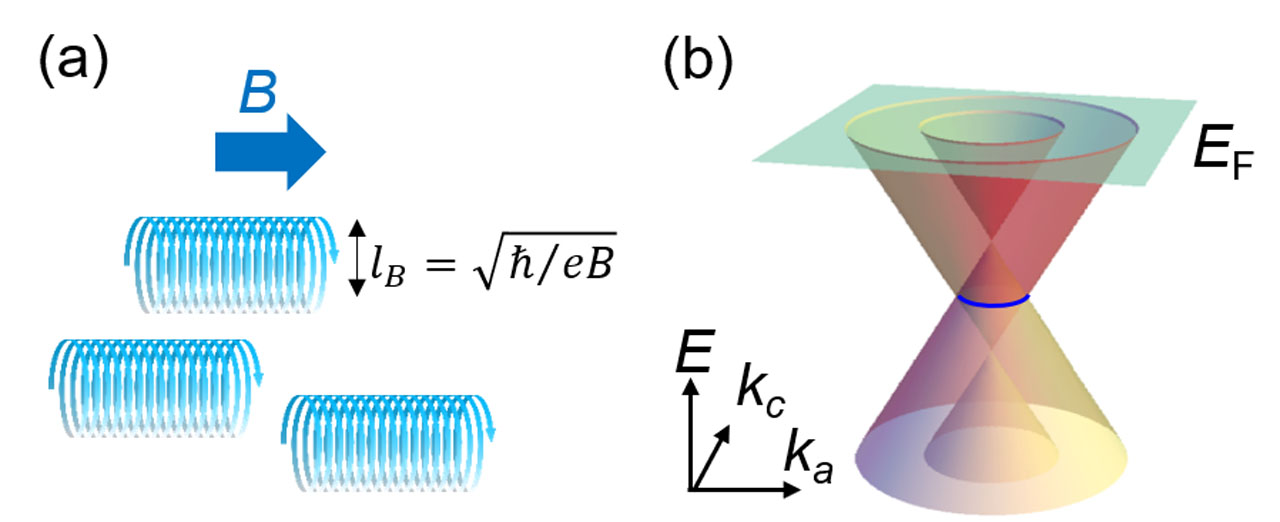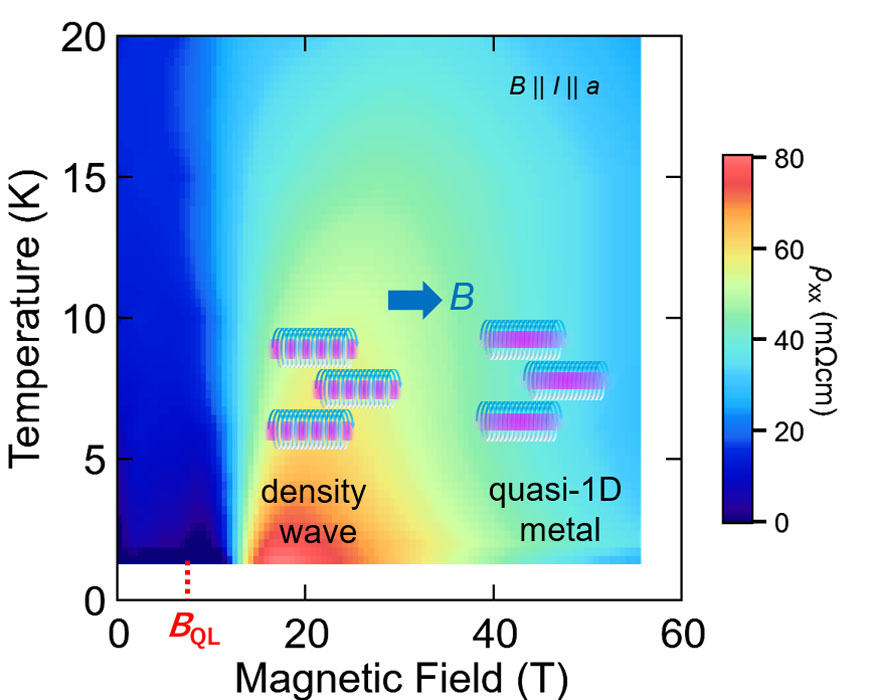Field-Induced Multiple Metal-Insulator Crossovers of Correlated Dirac Electrons of Perovskite CaIrO3
PI of Joint-use project: J. FujiokaHost lab: Tokunaga Group
The quantum phenomena of high-mobility relativistic electrons are issues of great interest in the modern condensed matter physics. So far, the quantum phenomena of relativistic electrons have been extensively studied in Dirac semimetals in which the electron correlation effect is small, but there is a growing interest in the quantum phenomena due to the strong electron correlations. One of fertile grounds to study this issue is the magnetically induced quantum limit (QL) in which the electrons are quasi-one-dimensionally (1D) confined under a sufficiently strong magnetic field B. In the QL, electrons in the lowest Landau level with the index n = 0 are confined in a scale of magnetic length lB = √ħ/eB within a plane perpendicular to the magnetic field, while the momentum along the magnetic field is preserved (Fig. 1(a)). Previous theoretical studies proposed that nontrivial phases such as the axion charge density wave (CDW) and excitonic insulator can be induced, if the QL of the Dirac/Weyl electron can be realized in materials with the strong electron correlation [1]. However, the experimental realization of quantum limit in the strongly correlated electron material is a challenge and hence it has rarely been explored so far.
In this context, the correlated Dirac semimetal of perovskite CaIrO3 provides an ideal arena to study the collective phenomena of high-mobility relativistic electrons in the QL. It has been proposed that the electron pocket emerging around U-point in the Brillouin zone of CaIrO3 is caused by the Dirac band dispersion with a closed line-node protected by the nonsymmorphic crystalline symmetry (Pbnm), as illustrated in Fig. 1(b). Recently, it has been shown that the line node is precisely tuned close to EF (~10 meV below EF) and yields the Dirac electrons with dilute carrier density (less than 2 × 1017 cm-3) and high mobility exceeding 60,000 cm2V-1s-1 due to strong electron correlations in the proximity to the Mott criticality [2]. As a result, the correlated Dirac electrons reach the QL at a modest magnetic field less than 10 T. However, the transport property in the QL of this material has not been explored so far, and a possibly striking feature of collective phenomena of the Dirac electrons remains elusive.
In this study, we have investigated the quantum limit transport of correlated Dirac electrons in the perovskite CaIrO3 by means of magneto-transport measurements up to 55 T and theoretical calculations [3]. In the QL, the magnetoresistivity steeply increases around 10 T and the insulating state with a finite energy gap emerges around 18 T (Fig. 2). By further increasing the magnetic field, both the gap and resistivity dramatically decrease, resulting in the quasi-1D metallic state in the deep QL regime. The non-monotonic field dependence of the gap suggests that the field-induced insulating state originates from the collective electronic ordering, likely the charge density wave or spin density wave driven by the Fermi surface instability inherent to the quasi-one-dimensional n = 0 Landau levels with the enhanced density of states under the magnetic field. The field-induced crossover between the metallic state and the gapped state appears in the fairly low magnetic field regime (10-30 T) among the conventional semimetals, highlighting the highly field-sensitive character of strongly correlated Dirac electrons relevant to the Mott criticality.
References
- [1] Z. Pan and R. Shindo, Phys. Rev. B 100, 165124 (2019).
- [2] J. Fujioka, R. Yamada, M. Kawamura, S. Sakai, M. Hirayama, R. Arita, T. Okawa, D. Hashizume, M. Hoshino, and Y. Tokura, Nat. Commun. 10, 362 (2019).
- [3] R. Yamada, J. Fujioka, M. Kawamura, S. Sakai, M. Hirayama, R. Arita, T. Okawa, D. Hashizume, T. Sato, F. Kagawa, R. Kurihara, M. Tokunaga, and Y. Tokura, npj Quantum Mater. 7, 13 (2022).


